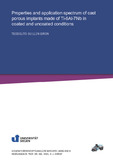Citation link:
https://nbn-resolving.org/urn:nbn:de:hbz:467-6738Files in This Item:
| File | Description | Size | Format | |
|---|---|---|---|---|
| guillen_giron.pdf | 15.89 MB | Adobe PDF |  View/Open |
| Dokument Type: | Doctoral Thesis | metadata.dc.title: | Properties and application spectrum of cast porous implants made of Ti-6Al-7Nb in coated and uncoated conditions | Authors: | Guillén Girón, Teodolito | Institute: | Institut für Werkstofftechnik | Free keywords: | Ti-6Al-7Nb Legierung, Biomechanische Untersuchung, Reaktionsschicht, Knochen, biomedizinischer Werkstoff, Ti-6Al-7Nb alloy, Biomechanical test, Reaction layer, animal bones | Dewey Decimal Classification: | 620 Ingenieurwissenschaften und Maschinenbau | GHBS-Clases: | ZHK | Issue Date: | 2012 | Publish Date: | 2012 | Series/Report no.: | Siegener werkstoffkundliche Berichte | Abstract: | This thesis presents the development, the characterization and the application of cast Ti-6Al-7Nb porous implants with respect to repair defects in cancellous bone. In the framework of this project, it was aimed at fabricating a porous implant with high mechanical strength to resist the applied load, a relatively low Young's modulus to prevent stress shielding phenomena, controlled cell dimensions to stimulate both mineral and collagen osseointegration, high porosity to guarantee interconnection between different pores, corrosion resistance under stress conditions and good biocompatibility. To identify the mechanical stresses and deformation behaviour that a porous implant should fulfil in order to substitute cancellous bone, bovine and ovine cancellous bone samples were compression tested. Ovine and bovine cancellous bone samples were used as models to understand their mechanical behaviours and the relationship between morphology and mechanical properties of the bone. In addition, a 45ppi open-cell AlSi7Mg foam was studied to understand the deformation mechanisms occurring during the compression test of metallic foams and the results were compared with those of the cancellous bones and of the Ti-6Al-7Nb porous implants. During the fabrication of the cast Ti-6Al-7Nb implants, defects associated to the casting process such as α-case and heterogeneous microstructure were found to reduce the mechanical properties of the samples. Therefore, an aging treatment was development in order to homogenize their microstructure. Brittle α-case was removed by using a pickling process in a HNO3+HF solution supported by ultrasonic vibration. Samples in heat-treated and acid-milled condition show an improvement of their ductility and strength. In this project, the surface chemistry of the implants was modified by using calcium titanate reaction layer with the aim to promote osseointegration. CaTiO3 coating was formed on the surface by immersing the implants in a salt-bath containing Ca(NiO3)2+NaNO3 and KNO3 for 2 hr at different temperatures (350°C, 410°C, 450°C und 510°C). The samples coated at 350°C show the best results after the fretting and cyclic bending test in corrosive environment and therefore this reaction layer was used on the implants. To evaluate the biological fixation and to analyse the biomechanical behaviour of coated and uncoated implants, in-vivo test were carried out by inserting the implants in "defects" created in the cancellous bone area of the distal femoral metaphyses of rats and sheep. After a recovering time of 30 days in rats and 6 months in sheep, the implants were extracted from the bone by using push-out test. Biomechanical results reveal high osseointegration in the vicinity and inside the porous implants which indicate high biocompatibility of both coated and uncoated implants. Diese Dissertation handelt von dir Entwicklung, Charakterisierung und Anwendung gegossener Ti-6Al-7Nb-Implantate zur Anwendung als Ersatzwerkstoff für spongiosen Knochen. Ziel im Rahmen dieser Arbeit war die Herstellung eines porosen Implantatkorpers mit ausreichend hoher mechanischer Festigkeit zur Übertragung der Betriebskräfte, der aber eine niedrige Steifigkeit zwecks Vermeidung von "stress shielding"-Phänomenen aufweist. Weitere wichtige Anforderungen an das Implantat sind kontrollierte Zellgroßenverteilungen, welche Osseointegration stimulieren, hohe Porosität zur Sicherstellung der Interkonnektion zwischen den Poren, Korrosionsbeständigkeit unter mechanischen Belastungen und gute Biokompatibilität. Die erforderlichen mechanischen Eigenschaften und das Verformungsverhalten, welches ein poroses Implantat erfüllen sollte, um die verletzte Spongiosa zu ersetzen, wurden mit Hilfe von Druckuntersuchungen an Proben von Rinder- und Schafspongiosa ermittelt. Rinder- und Schafspongiosa dienten ebenfalls als Modellwerkstoffe für das Verständnis bezüglich des Zusammenhangs zwischen Morphologie und mechanischen Kennwerten des Knochens. Zusätzlich wurde ein 45ppi offenporiger AlSi7Mg-Schaum mittels Druckversuch analysiert, um das mechanische Verformungsverhalten von metallischen Schäumen zu verstehen. Die Ergebnisse aus den mechanischen Untersuchungen an Knochen und Schäumen wurden mit den mechanischen Kennwerten der porosen Ti-6Al-7Nb-Implantate verglichen. Während der Herstellung der Ti-6Al-7Nb Implantate wurde festgestellt, dass durch das Gussverfahren hervorgerufene Defekte, wie z.B. α-case und heterogenes Gefüge, als Ursachen für die schlechten mechanischen Eigenschaften der Proben verantwortlich sind. Als Abhilfe führt die Verknüpfung einer Wärmebehandlung mit einem abschließenden Beizverfahren (70%HNO3 + 10%HF und 20%H2O) für ca. 60 min. zur Erhohung der Duktilität und Festigkeit gegossener Ti-6Al-7Nb Proben. In dieser Arbeit wurde die Oberflächenchemie der Implantate durch eine Calziumtitanat-Reaktionsschicht verändert, um die Osseointegration zu verbessen. Die CaTiO3-Schicht wurde in einem Salzbadverfahren mit Ca(NiO3)2 + NaNO3 und KNO3 bei verschiedenen Temperaturen aufgebracht. Bei einer Temperatur von 350°C beschichtete Proben zeigten das beste mechanische Verhalten in korrosivem Medium, weshalb diese Reaktionsschicht für die Implantatkorper angewendet wurde. Zur Evaluation der Osseointegration und des biomechanischen Verhaltens wurden beschichtete und unbeschichtete Implantate in Standarddefekte im spongiosen Bereich des Femurs von Ratten und Schafen eingebracht. Nach einer 30-tägigen Standzeit der Ratten und einer 6-monatigen Standzeit der Schafe wurden Ausdrückversuche durchgeführt, mit denen die Implantatkorper aus dem umgebenden Knochen herausgelost wurden. Die Ergebnisse der biomechanischen Versuche belegen ein hohes Maß an Osseointegration in der Umgebung und im Inneren der porosen Implantate, welche die hohe Biokompatibilität sowohl der beschichteten als auch der unbeschichteten Implantatkorper anzeigen. |
URN: | urn:nbn:de:hbz:467-6738 | URI: | https://dspace.ub.uni-siegen.de/handle/ubsi/673 | License: | https://dspace.ub.uni-siegen.de/static/license.txt |
| Appears in Collections: | Hochschulschriften |
This item is protected by original copyright |
Page view(s)
540
checked on Nov 25, 2024
Download(s)
163
checked on Nov 25, 2024
Google ScholarTM
Check
Items in DSpace are protected by copyright, with all rights reserved, unless otherwise indicated.

